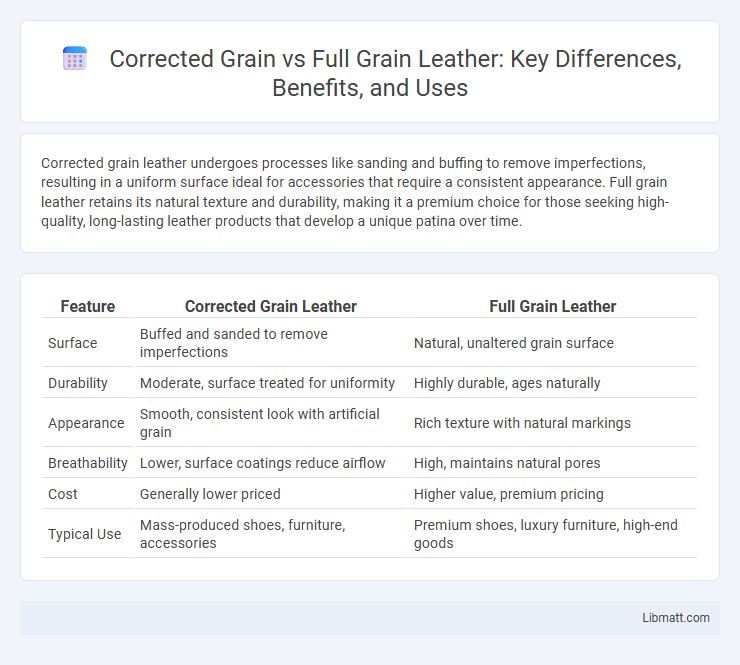Corrected grain leather undergoes processes like sanding and buffing to remove imperfections, resulting in a uniform surface ideal for accessories that require a consistent appearance. Full grain leather retains its natural texture and durability, making it a premium choice for those seeking high-quality, long-lasting leather products that develop a unique patina over time.
Table of Comparison
| Feature | Corrected Grain Leather | Full Grain Leather |
|---|---|---|
| Surface | Buffed and sanded to remove imperfections | Natural, unaltered grain surface |
| Durability | Moderate, surface treated for uniformity | Highly durable, ages naturally |
| Appearance | Smooth, consistent look with artificial grain | Rich texture with natural markings |
| Breathability | Lower, surface coatings reduce airflow | High, maintains natural pores |
| Cost | Generally lower priced | Higher value, premium pricing |
| Typical Use | Mass-produced shoes, furniture, accessories | Premium shoes, luxury furniture, high-end goods |
Introduction to Leather Grain Types
Corrected grain leather undergoes sanding and buffing to remove imperfections, followed by an artificial grain application for a uniform appearance. Full grain leather retains the natural surface, showcasing unique markings and developing a rich patina over time. These fundamental differences influence durability, texture, and aesthetic appeal in leather products.
Understanding Full Grain Leather
Full grain leather preserves the natural surface and grain patterns, offering superior durability and breathability compared to corrected grain leather, which undergoes sanding and artificial coatings to mask imperfections. This authentic material ages beautifully, developing a unique patina that enhances its aesthetic appeal over time. Understanding full grain leather is essential for recognizing high-quality leather goods that combine strength with natural beauty for your long-lasting investment.
What Is Corrected Grain Leather?
Corrected grain leather refers to hides that have been sanded or buffed to remove imperfections before applying an artificial grain layer, resulting in a more uniform surface. This type of leather is often coated with pigments and finishes to mimic the appearance of full grain leather while being more resistant to stains and abrasions. It is commonly used in furniture and automotive upholstery where durability and a consistent look are prioritized.
Key Differences Between Corrected Grain and Full Grain
Corrected grain leather undergoes surface sanding and buffing to remove imperfections, resulting in a uniform and smooth appearance, while full grain leather retains its natural surface, showcasing original markings and a more durable texture. Full grain leather develops a rich patina over time due to its intact grain structure, whereas corrected grain is often coated or embossed to mimic natural grain but can lack breathability and aging qualities. The key differences lie in durability, aesthetic authenticity, and the finishing process affecting texture and longevity.
Durability: Full Grain vs Corrected Grain
Full grain leather offers superior durability due to its natural surface retaining the complete grain structure, making it resistant to wear and tear over time. Corrected grain leather, treated and embossed to hide imperfections, is less durable because the surface is weakened by the finishing process. Your choice of full grain leather ensures longer-lasting products with a natural patina that improves with age, unlike the more compromised corrected grain varieties.
Appearance and Texture Comparison
Corrected grain leather features a uniform, smooth surface achieved by sanding away the top layer and applying a pigment coating, resulting in a consistent appearance but less natural texture. Full grain leather retains the original, unaltered surface with visible natural markings and a rich, tactile texture that develops a unique patina over time. Your choice between the two depends on whether you prefer a flawless look with less character (corrected grain) or a more authentic, textured feel with natural imperfections (full grain).
Common Uses for Full Grain Leather
Full grain leather is highly durable and commonly used for high-quality furniture, luxury handbags, and premium footwear due to its natural texture and strength. It ages beautifully with a unique patina, making it ideal for products requiring longevity and character. Your investment in full grain leather ensures superior performance and aesthetic appeal over time.
Typical Applications of Corrected Grain Leather
Corrected grain leather is commonly used in furniture upholstery, automotive interiors, and footwear where durability and consistent appearance are crucial. This leather undergoes surface sanding and embossing to correct imperfections, making it ideal for products requiring a uniform finish. Your choice of corrected grain leather ensures a stylish look combined with enhanced resistance to wear.
Price Differences and Value Considerations
Corrected grain leather is generally less expensive due to its surface being sanded and coated to mask imperfections, whereas full grain leather retains its natural surface, offering greater durability and aging potential. Your choice should balance initial costs with long-term value, as full grain leather often justifies a higher price with enhanced strength and aesthetic appeal over time. Investing in full grain leather means you receive superior quality that improves with use, while corrected grain leather provides a budget-friendly alternative with a consistent appearance but reduced longevity.
How to Choose Between Full Grain and Corrected Grain Leather
Choosing between full grain and corrected grain leather depends on your preference for durability and appearance; full grain leather offers natural strength and unique patina, while corrected grain leather provides a uniform finish with fewer imperfections. Your decision should consider the intended use, as full grain is ideal for long-lasting, high-quality items, and corrected grain suits budget-friendly options with consistent texture. Assessing factors like wear resistance, maintenance, and aesthetic appeal helps determine the best leather type for your needs.
Corrected grain vs full grain Infographic

 libmatt.com
libmatt.com